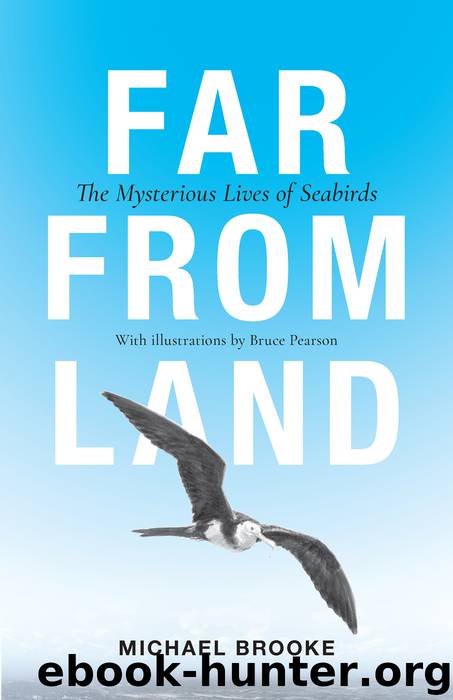Far from Land by Michael Brooke

Author:Michael Brooke
Language: eng
Format: epub
Publisher: Princeton University Press
Published: 2018-06-24T16:00:00+00:00
Figure-of-8 migration routes of 16 Short-tailed Shearwaters tracked from Great Dog Island, Tasmania. Reproduced with permission of BirdLife Australia, from the work cited in Note 19, Chapter 6.
* * *
In the previous sections, I have attempted an overview of how many aspects of seabirds’ lives are adapted to make efficient use of the winds that are such a feature of their marine domain. But the weather is variable. That is a statement of the obvious. The equally obvious corollary is that, at least sometimes, the weather can disrupt the birds’ lives. The disruption can run the full gamut, from a storm, which is a troublesome but temporary disruption to provisioning the young, to a full-blown life-threatening hurricane. Now then is the moment to describe how modern studies have revealed how horrid weather has inconvenienced seabirds, or worse. This is particularly relevant in current times when climate change models predict more variable weather, and a greater likelihood of stormy weather, for many parts of the world.
At the inconvenient end of the range of impacts is the effect of wind on European Shags feeding off Scotland’s east coast. Because the shags come ashore at night, the time spent foraging each day, as evidenced by daily number of hours with wet feet, could be determined when the immersion loggers on their feet were retrieved one or two years after first deployment. What Sue Lewis of Edinburgh University discovered was intriguing.21 Daily foraging time was lower when the wind was in the west than in the east, the latter associated with a long fetch across the North Sea and hence rougher seas. However daily foraging time dropped as wind speed increased. Putting it anthropomorphically, it perhaps became a waste of time for the shags to search for food in seas stirred up by stronger winds. But the decline in foraging with wind speed was more pronounced in the larger males than the smaller females.e Just why the females were the more inclined to continue feeding in worsening conditions remained unresolved.
Just as wind can cause problems for seabirds, so can rain. A nice example comes, unexpectedly, from Antarctica, the earth’s driest continent.f In late 2013, young downy Adélie Penguin chicks, beginning their lives in the continent’s French sector, experienced temperatures five degrees Celsius above normal. Precipitation, normally snow, fell as rain which drenched the chicks and caused the death of about half of them.22 Alas, the parents were not in a position to remain with the chicks to provide shelter. This was because the same weather that brought rain had failed to clear the ice close to shore. Thus, when foraging for their chicks, GPS-tracked parents were forced to travel twice the distance they covered in the previous season and were away at sea for around five days instead of three.
Without doubt, the weather can at times wreak greater havoc on seabirds. In particular, prolonged stormy weather can disrupt feeding opportunities. Weakened seabirds are then blown ashore, sometimes in huge numbers. In July 2011, the number of prions washed onto New Zealand’s shores perhaps exceeded one quarter of a million.
Download
This site does not store any files on its server. We only index and link to content provided by other sites. Please contact the content providers to delete copyright contents if any and email us, we'll remove relevant links or contents immediately.
| Amphibians | Animal Behavior & Communication |
| Animal Psychology | Ichthyology |
| Invertebrates | Mammals |
| Ornithology | Primatology |
| Reptiles |
Sapiens: A Brief History of Humankind by Yuval Noah Harari(13053)
The Tidewater Tales by John Barth(12030)
Do No Harm Stories of Life, Death and Brain Surgery by Henry Marsh(6337)
Mastermind: How to Think Like Sherlock Holmes by Maria Konnikova(6236)
The Thirst by Nesbo Jo(5786)
Why We Sleep: Unlocking the Power of Sleep and Dreams by Matthew Walker(5642)
Sapiens by Yuval Noah Harari(4537)
Life 3.0: Being Human in the Age of Artificial Intelligence by Tegmark Max(4508)
The Longevity Diet by Valter Longo(4445)
The Rules Do Not Apply by Ariel Levy(3906)
The Immortal Life of Henrietta Lacks by Rebecca Skloot(3826)
The Body: A Guide for Occupants by Bill Bryson(3802)
Why We Sleep by Matthew Walker(3773)
Animal Frequency by Melissa Alvarez(3755)
Yoga Anatomy by Kaminoff Leslie(3702)
Barron's AP Biology by Goldberg M.S. Deborah T(3632)
The Hacking of the American Mind by Robert H. Lustig(3580)
All Creatures Great and Small by James Herriot(3517)
Yoga Anatomy by Leslie Kaminoff & Amy Matthews(3396)
